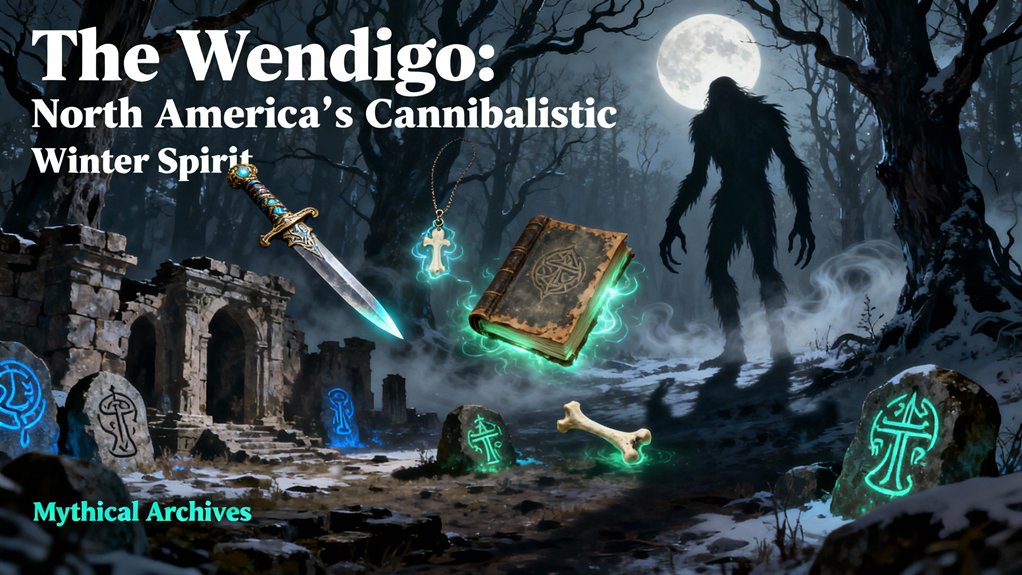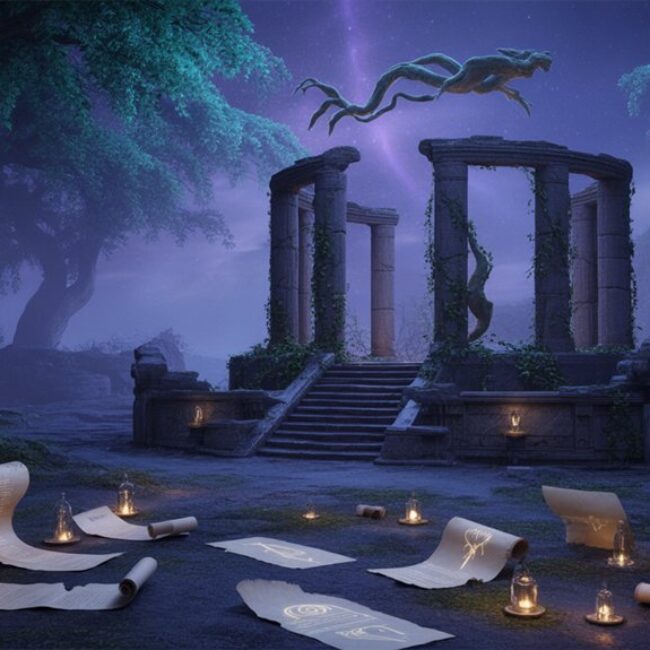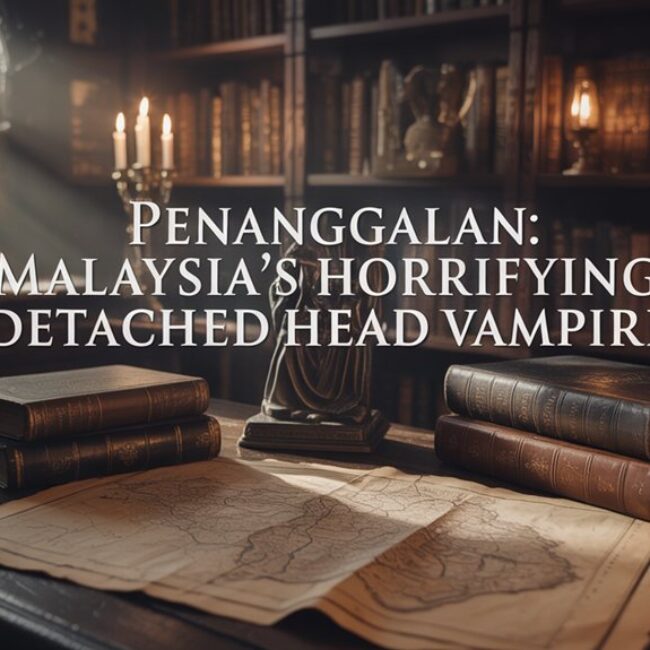The Wendigo materializes from Algonquian oral tradition as both spirit and psychosis—a skeletal, insatiable entity born when starvation drives humans toward cannibalism's ultimate transgression. You'll encounter this chimeric figure across winter storytelling ceremonies, where it serves as psychological safeguard against community collapse, possessing supernatural speed, bone-crushing strength, and regenerative capabilities that render conventional weapons useless. Historical records document fourteen executions for wendigo possession between 1823-1897, while the phenomenon persists through culture-bound syndrome and contemporary Indigenous reclamation efforts that reveal deeper ceremonial significance within this frozen mythology.
Key Takeaways
- The Wendigo is a psycho-spiritual entity from Algonquian folklore representing insatiable hunger and the taboo of cannibalism during winter starvation.
- Described as skeletal and emaciated, it possesses supernatural speed, strength, regenerative abilities, and tireless hunting capacity across arctic landscapes.
- Wendigo psychosis is a culture-bound syndrome causing compulsive cannibalistic urges, social withdrawal, and violent dreams despite food availability.
- Historical records document fourteen executions for wendigo possession between 1823-1897, including cases witnessed by French Jesuits and colonial authorities.
- Modern media transforms the Wendigo into horror entertainment, while Indigenous communities work to reclaim its original ceremonial and cautionary significance.
Origins in Algonquian Mythology and Oral Tradition
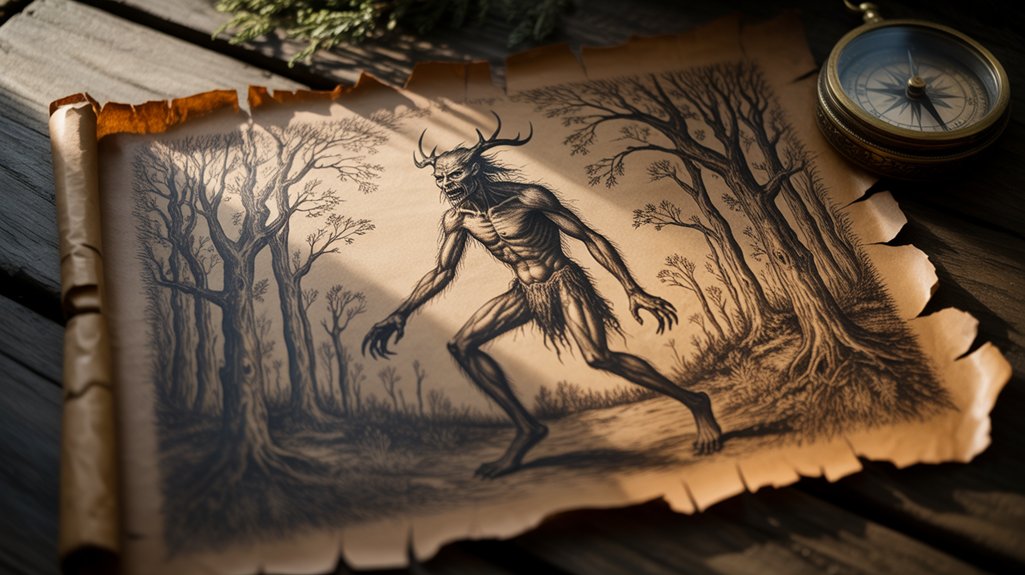
Among the Algonquian-speaking peoples scattered across the boreal forests and subarctic reaches of North America—the Ojibwe, Cree, Innu, and their linguistic cousins—the wendigo emerged not as mere folklore but as a psycho-spiritual framework for understanding the most profound transgression imaginable.
You'll find this entity woven through centuries of oral tradition, transmitted through winter storytelling ceremonies when darkness claimed twenty hours of each day. The Algonquian legends describe alteration: a human who consumes human flesh becomes something chimeric, neither animal nor person.
Starvation periods tested communities. Cannibalism represented collapse. Wendigo folklore codified this horror into a cautionary architecture, teaching that certain boundaries, once crossed, remake you at the ontological level.
The creature embodied eldritch hunger—insatiable, eternal, growing larger with each feeding yet perpetually emaciated. These teachings weren't superstition. They were survival psychology, embedding taboo so deeply into cultural consciousness that violation became literally unthinkable, even when winter stretched lean and death whispered through pine stands.
Physical Characteristics and Supernatural Abilities
The wendigo manifests as an eldritch paradox—simultaneously corporeal and spectral, its skeletal frame towers above the winter pines, flesh drawn taut over protruding bones, or in some accounts, entirely absent to reveal the yellowed architecture of death itself.
You'll find descriptions from Cree, Ojibwe, and Innu oral histories consistently emphasizing its impossible velocity through snow-laden forests, supernatural strength capable of shattering frozen timber, and a horrifying capacity for regeneration that renders conventional weapons useless against its cursed form.
The creature's chimeric nature extends to shape-shifting abilities documented in nineteenth-century missionary accounts, where witnesses claimed the wendigo could appear as familiar faces, distorted animals, or simply as howling wind carrying the stench of carrion across the subarctic wilderness.
Skeletal, Gaunt Appearance
Starvation personified—this captures the wendigo's most horrifying physical trait, a body that defies natural law through its paradoxical emaciation.
You'll encounter descriptions of creatures so skeletal that ribs protrude through translucent, ash-gray skin stretched impossibly tight across bone. The wendigo's gauntness transcends mere hunger—it embodies insatiable appetite, growing more emaciated with each victim consumed, its flesh withering even as it feeds.
Wendigo symbolism reflects this cruel irony: eternal starvation despite endless consumption. Cultural interpretations among Algonquian peoples present this eldritch form as divine punishment, a visual manifestation of greed's self-destructive nature.
Eye sockets sink deep into skull-like faces. Limbs extend grotesquely. This corporeal horror serves warning—excess breeds emptiness, consumption begets deprivation, and those who transgress natural order become monuments to their own ravenous destruction.
Supernatural Speed and Strength
Beyond its nightmarish appearance lies power that shatters human comprehension—velocity and force operating outside natural constraints, changing the wendigo from mere monster into apex predator of impossible caliber.
This creature's supernatural agility defies physics itself, traversing frozen wilderness with movements that blur between dimensions. Witnesses describe acceleration beyond measurement, the wendigo materializing across impossible distances within heartbeats. Its monstrous endurance surpasses mortality's limits, pursuing prey through weeks of relentless winter without sustenance or rest.
Documented capabilities include:
- Instantaneous pursuit across miles of trackless snow without footprints
- Bone-crushing strength capable of rending trees and shattering frozen earth
- Tireless hunting throughout endless arctic nights
- Supernatural perception detecting human presence through blizzards
- Immunity to temperatures that would obliterate human tissue
This eldritch combination converts escape into futile fantasy.
Shape-Shifting and Regeneration
When physical destruction meets wendigo flesh, conventional mortality ceases to apply—this entity possesses regenerative properties that mock the permanence of injury, rendering fatal wounds into temporary inconveniences.
You'll find that Algonquian oral traditions describe these regenerative traits as extensions of winter's eternal return, wounds closing like frozen lakes healing their cracks.
The creature's shape shifting abilities remain contested among ethnographic records; some accounts position the wendigo as fixed within its emaciated form, while others—particularly Cree testimonies from the 1800s—speak of chimeric alterations, the beast assuming forms both lupine and humanoid.
This eldritch mutability serves its predatory nature.
Survival depends on understanding that destroying such an entity requires methods transcending physical violence, demanding spiritual intervention that addresses its corrupted essence rather than merely its corporeal manifestation.
The Psychological Phenomenon of Wendigo Psychosis
Although documented mainly in twentieth-century anthropological literature, wendigo psychosis—also termed witiko psychosis—represents a culture-bound syndrome that emerged from the harsh realities of Algonquian winter survival.
You'll find this phenomenon surpasses mere medical classification, existing in that eldritch space where cultural terror manifests as psychological affliction. Those experiencing wendigo symptoms reported overwhelming compulsions toward cannibalism, even amid available food sources—a chimeric blending of starvation anxiety and spiritual contamination.
The psychological effects created a devastating spiral:
Psychological devastation cascaded through victims as cannibalistic compulsions merged with spiritual dread, creating an inescapable descent into madness.
- Melancholia and profound social withdrawal preceding the cannibalistic urges
- Insomnia accompanied by increasingly violent dreams of consumption
- Perceived bodily alteration, believing one's heart had frozen to ice
- Absolute conviction of wendigo possession, regardless of physical health
- Suicidal ideation or requests for execution to prevent harming others
This syndrome illuminated how survival pressures, spiritual cosmology, and individual psychology intertwined within indigenous communities facing winter's merciless dominion.
Historical Accounts and Documented Cases
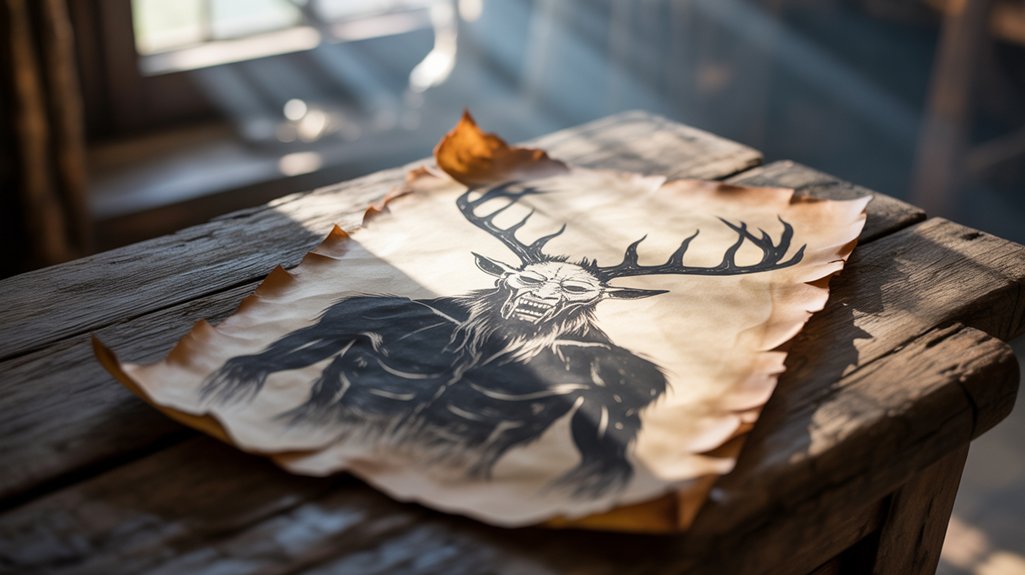
You'll find the wendigo's presence etched across centuries of testimony, from the primordial oral chronicles preserved by Algonquian peoples through generations of winter storytelling, to the trembling journal entries of French voyageurs who documented encounters with starving, altered men in the forbidding wilderness of the 1600s.
These accounts intensified during the colonial expansion, when Hudson's Bay Company traders recorded inexplicable acts of cannibalism among isolated trappers, their reports clinical yet unable to mask an underlying dread.
The phenomenon persisted into the twentieth century—psychologists and anthropologists between 1900 and 1960 catalogued forty-one cases of so-called “wendigo psychosis,” individuals consumed by an insatiable hunger that changed them into the very chimeric entity they feared.
Early Indigenous Oral Traditions
Before European chroniclers ever pressed quill to parchment regarding the wendigo, Algonquian peoples—spanning from the Atlantic forests through the subarctic reaches of present-day Quebec, Ontario, and Manitoba—had preserved intricate oral narratives of this malevolent entity for countless generations.
Through oral storytelling, elders transmitted warnings of change: how starvation's grip could remake human flesh into something chimeric, something hungering. Cultural transmission occurred during winter's darkest months, when families gathered close.
These traditions carried essential survival knowledge:
- Psychological warnings against isolation's mind-breaking effects during extended wilderness sojourns
- Moral boundaries defining taboos that preserved communal cohesion when resources dwindled
- Spiritual frameworks explaining eldritch forces beyond human comprehension
- Practical wisdom recognizing behavioral changes signaling dangerous psychological deterioration
- Ceremonial protections enabling communities to confront manifestations through shamanic intervention
The stories weren't mere entertainment. They were sovereignty itself—autonomous knowledge systems predating colonial contact.
Colonial Explorer Encounters
When French Jesuits and fur traders penetrated the boreal forests during the seventeenth century, they encountered accounts that defied their European frameworks of understanding—accounts that would find their way into mission records, trading post journals, and colonial correspondence with disturbing frequency.
You'll find these colonial narratives documenting what they termed “possession by savage spirits,” though their interpretations couldn't capture the eldritch nature of wendigo alteration.
Explorer journals from 1636 onward describe emaciated figures wandering winter camps, their chimeric forms neither fully human nor beast.
Paul Le Jeune's Relations detail incidents where hunters, isolated and starving, developed an insatiable craving for human flesh—a change that Indigenous guides recognized immediately.
These weren't mere starvation cases. Something older stirred in those frozen territories, demanding acknowledgment beyond colonial comprehension.
20th Century Documented Reports
As the nineteenth century unfolded across the Great Lakes region and Canadian Shield territories, documented wendigo cases shifted from missionary observations to official governmental records, medical reports, and criminal proceedings—a bureaucratic cataloging that paradoxically lent credence to what colonial authorities desperately wished to dismiss as “savage superstition.”
The archives reveal a pattern: between 1823 and 1897, at least fourteen individuals were executed by their own communities for wendigo alteration, with Hudson's Bay Company factors and North-West Mounted Police officers filing reports that struggled to rationalize what they'd witnessed.
These 19th century sightings crystallized into documented encounters that defied European frameworks:
- Jack Fiddler's 1907 trial, where he confessed to killing fourteen altered beings
- Starvation-winter alterations correlating with documented encounters during brutal isolation periods
- Eldritch symptoms: insatiable hunger despite available food, speaking unknown languages
- Swift Runner's 1879 execution after consuming his entire family
- Medical officers documenting chimeric psychological deterioration they couldn't categorize
Cultural Significance and Taboo Against Cannibalism
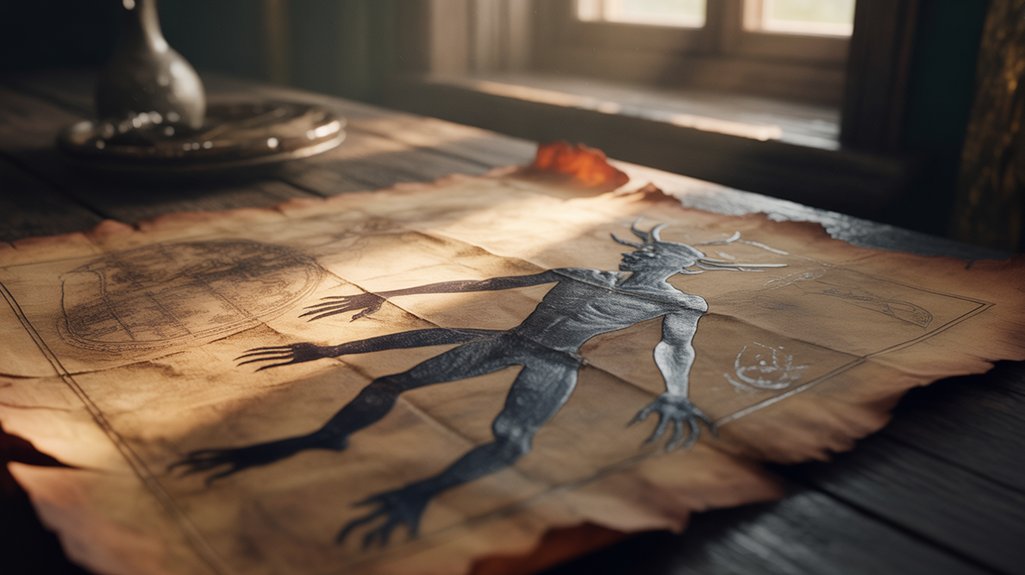
The wendigo legend serves as perhaps the most powerful psychological safeguard against cannibalism ever developed by an indigenous culture, functioning as both supernatural deterrent and social enforcement mechanism among the Algonquian peoples of the subarctic regions. You'll find this cannibalism taboo woven through every winter survival story, each warning carrying the weight of eldritch alteration awaiting those who consume human flesh.
The cultural significance manifests through systematic enforcement:
| Social Mechanism | Function |
|---|---|
| Oral narratives | Transmit transgression consequences across generations |
| Shamanic intervention | Identify potential wendigo possession early |
| Community exile | Remove infected individuals before alteration completes |
| Preventive execution | Eliminate threats to collective survival |
| Ceremonial restrictions | Reinforce behavioral boundaries during famine |
This chimeric entity doesn't merely prohibit cannibalism—it alters the act into irreversible damnation. You're not simply breaking tribal law; you're surrendering your humanity entirely, becoming insatiable hunger incarnate, forever wandering the frozen wastes.
The Wendigo in Modern Popular Culture
Since the mid-20th century, this creature of Algonquian origin has undergone systematic modification from culturally-specific cautionary entity into generalized horror iconography, stripped of ceremonial context yet amplified in visceral terror.
You'll encounter Wendigo symbolism permeating contemporary media—novels, films, video games—where Wendigo representation alters ancestral warnings into commercial entertainment. This commodification creates tension between cultural preservation and artistic freedom.
Modern interpretations manifest through:
- Eldritch redesigns featuring chimeric antler-crowned humanoids replacing traditional gaunt cannibals
- Video game antagonists (Until Dawn, 2015) prioritizing jump-scares over spiritual consequences
- Literary appropriations divorcing hunger-madness from starvation contexts
- Horror film monsters emphasizing physical grotesquery rather than psychological corruption
- Indigenous reclamation efforts reasserting ceremonial significance against mainstream dilution
You witness parallel narratives: mainstream culture exploiting surface aesthetics while Indigenous communities maintain authentic traditions.
The paradox persists—popularization guarantees survival through visibility, yet threatens dissolution through misrepresentation. Ancient knowledge circulates, modified yet recognizable, between reverence and exploitation.
Regional Variations Across Indigenous Nations
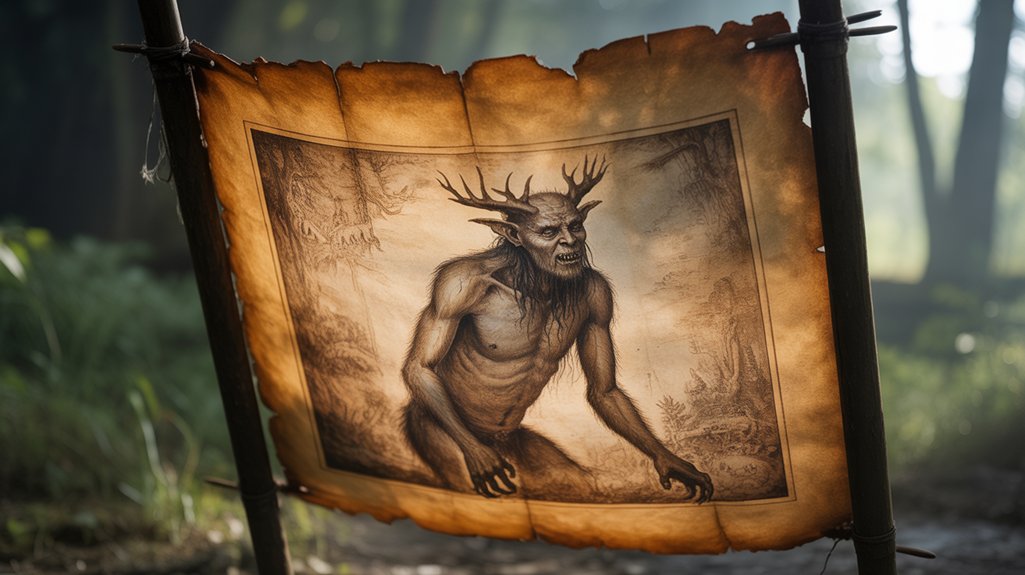
Algonquian-speaking peoples spanning from Atlantic maritime provinces through boreal forests to Great Plains territories developed distinct conceptualizations of this malevolent spirit, each iteration reflecting geographic hardships and ceremonial frameworks unique to their landscape.
You'll find Ojibwe traditions emphasize psychospiritual alteration—starvation births the eldritch hunger. Cree narratives position the entity as chimeric amalgamation, part human, part beast, wholly corrupted. The Innu conceptualize it through seasonal deprivation cycles haunting their subarctic territories. Mi'kmaq accounts stress communal protection protocols against possession.
Wendigo beliefs vary profoundly. Eastern Algonquian groups treat it as cautionary metaphor; northern communities regard it as tangible threat requiring shamanic intervention.
You're encountering living Indigenous narratives, not fossilized folklore. These regional distinctions matter—they reveal how environment shapes cosmology, how isolation breeds specific terrors. The creature adapts, alters, reflects each nation's intimate relationship with winter's cruelty, famine's devastation, and the fragile membrane separating civilization from primal dissolution.
Frequently Asked Questions
How Can Someone Protect Themselves From Encountering a Wendigo in the Wilderness?
You'll find protection through rigorous preventative measures rooted in Algonquian wisdom: never consume human flesh, even when starvation beckons from winter's eldritch void.
Master wilderness survival skills—fire-building, shelter construction, adequate provisions—to avoid desperation's grip.
The Cree and Ojibwe elders understood: spiritual fortitude matters most. Carry tobacco for offerings, respect the forest's ancient boundaries, travel in groups when possible.
Liberation from the wendigo's chimeric hunger comes through preparation, reverence, and acknowledging forces beyond rationality's comfortable borders.
Are There Any Recorded Cases of Wendigo Attacks in Recent Decades?
You'll find documented Wendigo psychosis cases peaked between 1840-1920, with roughly 70 recorded incidents among Algonquian communities.
Modern sightings have shifted dramatically—no authenticated attacks exist in recent decades, though Wendigo folklore persists through cryptozoological reports from Minnesota's Boundary Waters and Ontario's northern forests.
These contemporary encounters, lacking the chimeric cultural context of historical manifestations, remain anecdotal rather than forensic.
You're witnessing mythology's alteration into campfire legend, divorced from its original eldritch spiritual framework.
What Should You Do if You Suspect Someone Has Wendigo Psychosis?
If you suspect someone's experiencing wendigo psychosis, seek immediate mental health intervention from professionals familiar with Indigenous cultural beliefs.
Warning signs include obsessive thoughts about cannibalism, paranoia, violent impulses, and dissociation from reality.
Respect that this condition exists within specific Algonquian contexts, intertwining psychological distress with spiritual dimensions.
Don't attempt amateur exorcisms or interventions—you'll need culturally-competent practitioners who honor traditional healing alongside psychiatric care, bridging eldritch folklore with modern understanding.
Can a Person Who Becomes a Wendigo Ever Be Returned to Normal?
Like crossing frozen ice that'll never thaw, Wendigo alteration marks a spiritual point of no return in Algonquian tradition.
You won't find accounts of spiritual redemption—the metamorphosis fundamentally corrupts one's essence, irrevocably severing humanity's sacred bonds.
Historical records, spanning centuries of oral testimony, consistently affirm this eldritch permanence.
Once the chimeric curse takes hold, consuming both flesh and soul, you've passed beyond mortal intervention.
Traditional healers couldn't reverse what starvation, cannibalism, and malevolent spirits had utterly altered.
Are There Specific Months When Wendigo Sightings Are Most Commonly Reported?
You'll find Wendigo sightings cluster mainly during winter's harshest months—December through March—when blizzards isolate communities and starvation's specter looms closest.
These seasonal patterns align precisely with the creature's eldritch nature as a winter-born malevolence.
Historical accounts from Algonquian territories reveal increased reports during periods of extreme cold, when the boundary between human desperation and supernatural alteration grows perilously thin.
The creature's manifestation corresponds directly with environmental conditions that birthed its legend: frozen landscapes where survival demands impossible choices.
Conclusion
You've journeyed through centuries of Algonquian wisdom, traced the wendigo's eldritch alteration from human to chimeric horror. Consider this: anthropologists documented over seventy cases of wendigo psychosis between 1661 and 1960, each account threading starvation's desperation with cultural transgression. These weren't mere folklore—they're humanity's acknowledgment of winter's psychological toll, cannibalism's ultimate taboo. The wendigo endures because it's real, not as flesh but as warning, reminder, consequence.
